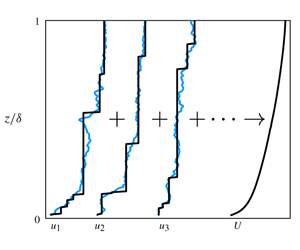Crossref Citations
This article has been cited by the following publications. This list is generated based on data provided by
Crossref.
Ali, Sk Zeeshan
and
Dey, Subhasish
2020.
The law of the wall: A new perspective.
Physics of Fluids,
Vol. 32,
Issue. 12,
Heisel, Michael
Katul, Gabriel G.
Chamecki, Marcelo
and
Guala, Michele
2020.
Velocity asymmetry and turbulent transport closure in smooth- and rough-wall boundary layers.
Physical Review Fluids,
Vol. 5,
Issue. 10,
Salesky, S. T.
and
Anderson, W.
2020.
Coherent Structures Modulate Atmospheric Surface Layer Flux-Gradient Relationships.
Physical Review Letters,
Vol. 125,
Issue. 12,
Tang, Zhanqi
Fan, Ziye
Chen, Letian
and
Jiang, Nan
2021.
Outer-layer structure arrangements based on the large-scale zero-crossings at moderate Reynolds number.
Physics of Fluids,
Vol. 33,
Issue. 8,
Heisel, Michael
de Silva, Charitha M.
Hutchins, Nicholas
Marusic, Ivan
and
Guala, Michele
2021.
Prograde vortices, internal shear layers and the Taylor microscale in high-Reynolds-number turbulent boundary layers.
Journal of Fluid Mechanics,
Vol. 920,
Issue. ,
Chen, Xue
Chung, Yongmann M.
and
Wan, Minping
2021.
The uniform-momentum zones and internal shear layers in turbulent pipe flows at Reynolds numbers up to Reτ=1000.
International Journal of Heat and Fluid Flow,
Vol. 90,
Issue. ,
p.
108817.
Anderson, W.
and
Salesky, Scott T.
2021.
Uniform momentum zone scaling arguments from direct numerical simulation of inertia-dominated channel turbulence.
Journal of Fluid Mechanics,
Vol. 906,
Issue. ,
Deshpande, Rahul
de Silva, Charitha M.
Lee, Myoungkyu
Monty, Jason P.
and
Marusic, Ivan
2021.
Data-driven enhancement of coherent structure-based models for predicting instantaneous wall turbulence.
International Journal of Heat and Fluid Flow,
Vol. 92,
Issue. ,
p.
108879.
Heisel, Michael
de Silva, Charitha M.
Katul, Gabriel G.
and
Chamecki, Marcelo
2022.
Self-similar geometries within the inertial subrange of scales in boundary layer turbulence.
Journal of Fluid Mechanics,
Vol. 942,
Issue. ,
Das, S.
Balachandar, R.
and
Barron, R.M.
2022.
Generation and characterization of fully developed state in open channel flow.
Journal of Fluid Mechanics,
Vol. 934,
Issue. ,
Laskari, Angeliki
de Silva, Charitha M.
Hutchins, Nicholas
and
McKeon, Beverley J.
2022.
Spatiotemporal characteristics of uniform momentum zones: Experiments and modeling.
Physical Review Fluids,
Vol. 7,
Issue. 10,
Zheng, Y.
and
Anderson, W.
2022.
Evidence that uniform momentum zones originate from roughness sublayer structure interactions in fully rough channel turbulence.
Journal of Fluid Mechanics,
Vol. 944,
Issue. ,
Scarano, Francesco
Jacob, Marc C.
Carbonneau, Xavier
and
Gowree, Erwin R.
2022.
On the turbulent boundary layer over a flat plate at moderate Reynolds numbers.
Physics of Fluids,
Vol. 34,
Issue. 11,
Gangwar, Tarun
Susko, Alexander Q.
Baranova, Svetlana
Guala, Michele
Smith, Kevin P.
and
Heuschele, D. Jo
2023.
Multi-scale modelling predicts plant stem bending behaviour in response to wind to inform lodging resistance.
Royal Society Open Science,
Vol. 10,
Issue. 1,
Wang, Yu-Fei
Huang, Yi-Jun
Zhang, Jin-Hao
Tian, Hai-Ping
and
Jiang, Nan
2023.
Uniform momentum zones on the smooth and superhydrophobic surfaces in a turbulent boundary layer.
Acta Mechanica Sinica,
Vol. 39,
Issue. 8,
Zhang, Jin-Hao
Li, Biao-Hui
Su, Jing-Bo
and
Jiang, Nan
2023.
Influence of synthetic jet on uniform momentum zones.
International Journal of Heat and Fluid Flow,
Vol. 101,
Issue. ,
p.
109131.
Heisel, Michael
Sullivan, Peter P.
Katul, Gabriel G.
and
Chamecki, Marcelo
2023.
Turbulence Organization and Mean Profile Shapes in the Stably Stratified Boundary Layer: Zones of Uniform Momentum and Air Temperature.
Boundary-Layer Meteorology,
Vol. 186,
Issue. 3,
p.
533.
Salesky, Scott T.
2023.
Uniform momentum and temperature zones in unstably stratified turbulent flows.
Journal of Fluid Mechanics,
Vol. 958,
Issue. ,
Fu, Xiaoyan
Li, Ruijie
Li, Yuting
and
Quan, Xiufeng
2024.
The distribution of velocity and sediment concentration under currents in coastal seas.
Desalination and Water Treatment,
Vol. 319,
Issue. ,
p.
100488.
Lai, Yanhong
Yang, Jun
and
Kang, Wanying
2024.
Ocean Circulation on Tide-locked Lava Worlds. I. An Idealized 2D Numerical Model.
The Planetary Science Journal,
Vol. 5,
Issue. 9,
p.
204.


